The Secret Life Under the Sea: Amazing Adaptation of Marine Animals
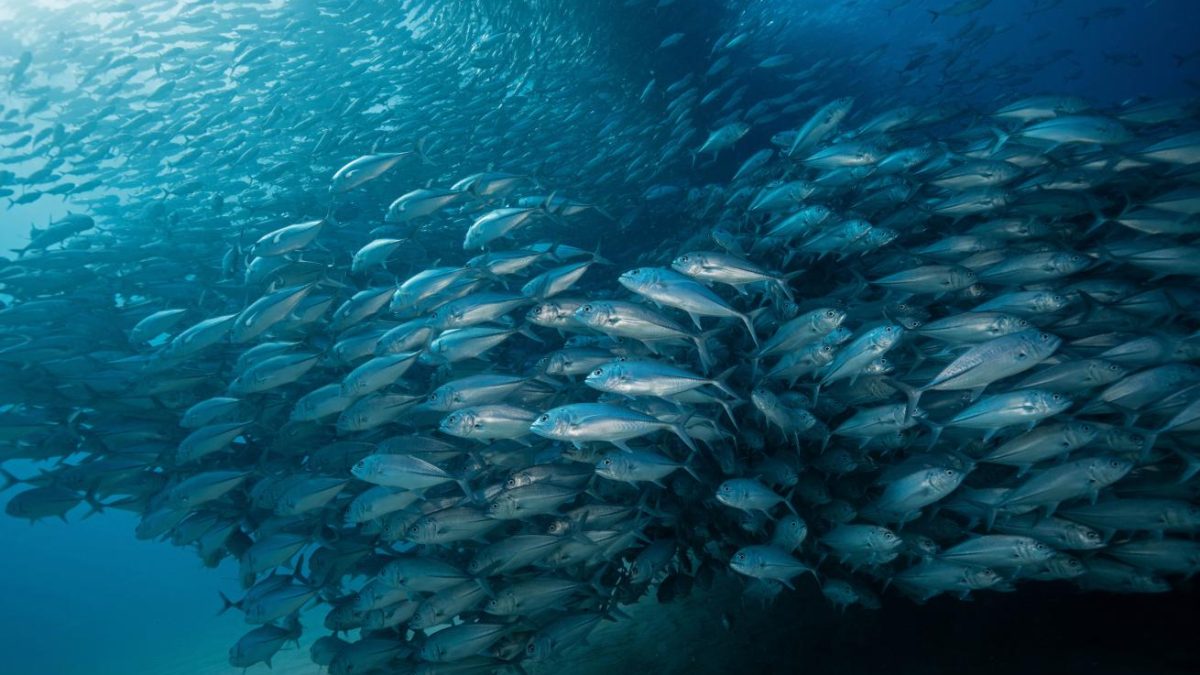
Bigeye jack, also known as the bigeye trevally, schools in Cabo Pulmo, Mexico (Photo Credit : Kristin Paterakis)
The underwater world is a realm filled with wonders and mysteries. The vast oceans harbour an immeasurable wealth of biodiversity. From the warm depths of the tropics to the frozen waters of the Arctic, the sea is home to a diverse array of astonishing species. Every corner of the seafloor, every current of water, and every coral reef harbours unique life that has remarkably adapted to its environment. These marine animals have evolved over thousands, even millions of years, to survive in habitats that can sometimes be extreme and challenging.
Understanding the adaptations of marine animals is key to understanding and preserving life under the sea. Each unique ability possessed by marine species is the result of a long process of evolution, adapting to the pressures and extreme conditions of the environment. Delving into the secrets of these adaptations will open a new window onto the wonders hidden in the ocean depths.
By studying how marine animals adapt, we can gain valuable insights into the health and balance of marine ecosystems. Changes in adaptation patterns can be an indicator of disturbances or significant changes in the marine environment. Understanding the adaptations of marine animals can help us identify potential threats, such as global warming, pollution, or overfishing.
In addition, knowledge about adaptations can provide valuable guidance in efforts to conserve and restore marine environments. We can design more effective protection strategies by considering the needs and adaptation capabilities of key species. Understanding how marine animals survive can help us create more conducive conditions for their survival and development.
Types of Marine Animal Adaptations
- Physiological Adaptations of Marine Animals
- Osmoregulation
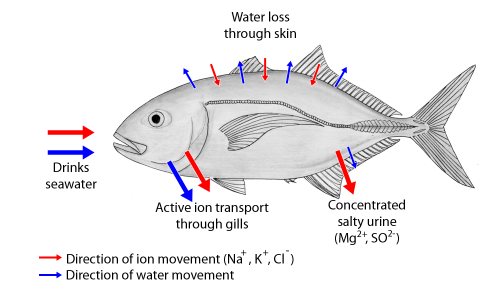
Movement of water and ions in saltwater fish (Photo Credit : Kare Kare)
Regulating Salt Balance in the body is one of the main challenges faced by marine animals is maintaining the balance of salt levels in their bodies. The marine environment has a much higher salinity compared to the body fluids of animals. To overcome this, marine animals have developed effective osmoregulation mechanisms. Sea fish, for example, have gills capable of filtering and removing excess salt from their bodies. Meanwhile, some other types of sea fish can convert salt into urea which is then stored in the body. In this way, they can maintain the appropriate osmotic pressure within their cells. Likewise with other marine animals such as molluscs and crustaceans. They use various mechanisms, including regulating ion levels and producing solutes, to maintain the balance of water and electrolytes in their bodies. This osmoregulation adaptation allows marine animals to live and reproduce in environments with very high salinity.
- Tolerance to Different Water Temperatures
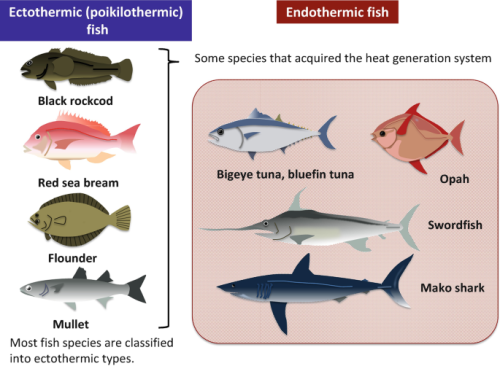
Tolerance to different water temperatures in fish (Photo Credit : Kiyoshi Soyano & Yuji Mushirobira)
The ocean has a very wide range of water temperatures, from warm tropical waters to freezing Arctic waters. Marine animals must adapt to these extreme temperature fluctuations in order to survive. Some species develop the ability to regulate their body temperature internally, like tuna and sharks. They have special mechanisms to maintain a body temperature that is warmer than their surroundings. Meanwhile, other marine organisms rely on physiological changes, such as changes in the lipid composition in cell membranes, to adjust to temperature differences. Adaptation to temperature also allows marine animals to reproduce and survive in various thermal zones. Eggs and larvae can even adapt to temperature changes during their developmental stages.
- Respiration with Gills: Efficiency in Oxygen Absorption
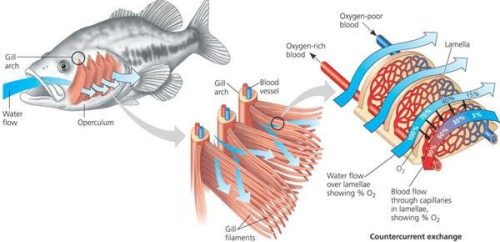
The passage of blood and water in fish gill (Photo Credit : BioTopics.co.uk)
The dense marine water environment requires special adaptations so that marine animals can obtain enough oxygen to survive. In this case, gills become a very important respiratory organ for the majority of marine animals. The gills of marine animals are designed efficiently to absorb dissolved oxygen from seawater. The extensive lamella structure and blood vessels close to the gill surface maximize the gas exchange process. In addition, some species have the ability to increase the flow of water through their gills when their activity increases, ensuring an adequate supply of oxygen. This respiratory adaptation is not only important for fish, but also for various molluscs, crustaceans, and even marine mammals like whales and dolphins. The ability to efficiently utilize dissolved oxygen is key to the success of marine animals in inhabiting their unique underwater habitats.
- Osmoregulation
- Morphological Adaptations of Marine Animals
- Streamlined Body Shape for Efficient Swimming
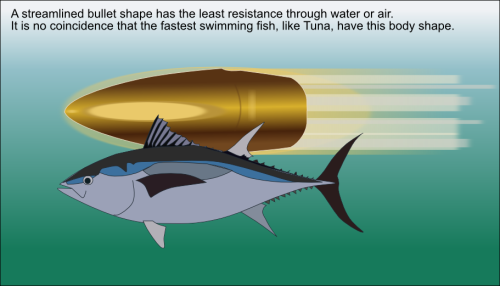
Streamlined body shape for efficient swimming (Photo Credit : Canberra & District Aquarium Society)
To survive and move effectively in water, marine animals have developed a highly streamlined body shape. This sleek and elongated form allows them to swim more easily and conserve energy. Fish, for example, have a slim body with smooth scales. This shape helps reduce water resistance when swimming and allows for quick and agile movements. Similarly, marine mammals like whales and dolphins have a highly streamlined body shape that enables them to swim at high speeds. In addition, marine animals have developed strong tails and fins as well as a wide range of movement. All these morphological adaptations allow them to move with efficient energy, whether chasing prey, avoiding predators, or moving around in the aquatic environment.
- Structure of Fins, Legs, and Other Locomotive Tools
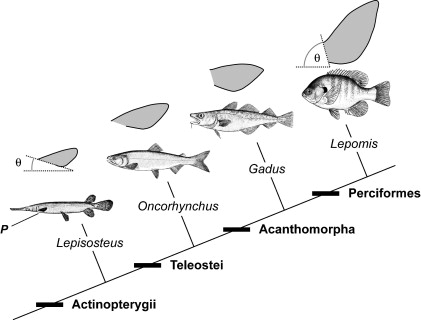
Structure of fins (Photo Credit : Eliot G. Drucker, Jeffrey A. Walker & Mark W. Westneat)
To adapt well underwater marine animals also have various specialized structures for movement. Fish, for example, have fins that are modified for propulsion, steering, and turning while swimming. The shape and size of the fins vary according to the lifestyle and needs of each species. In addition, crustaceans like shrimp and crabs have legs equipped with segments and joints that allow them to move agilely on the seafloor. These leg structures also function to hold and grasp objects. Some marine animals even have tentacles or arms that can be used to crawl, catch prey, or move. With these diverse morphological adaptations, marine animals can move and adapt to various water environment conditions, whether on the surface, in the water column, or on the seafloor.
- Smooth and Flexible Skin to Reduce Friction
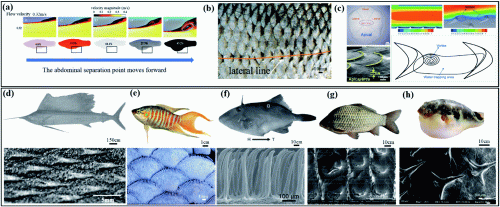
Smooth and flexible skin to reduce friction (Photo Credit : Guizhong Tian, Dongliang Fan, Xiaoming Feng & Honggen Zhou)
To move efficiently in water, marine animals also have very smooth and flexible skin. The smooth and layered surface of the skin helps reduce water resistance when swimming. Fish, for example, have layered and slick scales, helping them move quickly and agilely. Meanwhile, marine mammals like whales and dolphins have extremely smooth and flexible skin, allowing them to swim at high speeds. In addition, the flexible skin also helps marine animals adapt to changes in water pressure as they move up and down in the water column. These morphological adaptations are key to the success of marine animals in inhabiting and moving efficiently in aquatic environments.
- Streamlined Body Shape for Efficient Swimming
- Behavioral Adaptations of Marine Animals
- Migration and Movement of Marine Animals
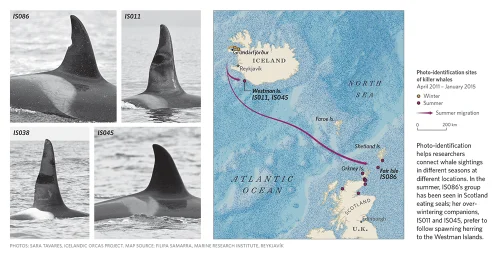
Whale Migrations (Photo Credit : James Cheshire & Oliver Uberti)
Many marine animals undergo periodic migration or movement to find food, reproduce, or avoid unfavorable environmental conditions. For example, whales and tuna fish migrate seasonally to follow the movement of plankton and small fish, their food sources.
- Hunting Behavior and Group Hunting
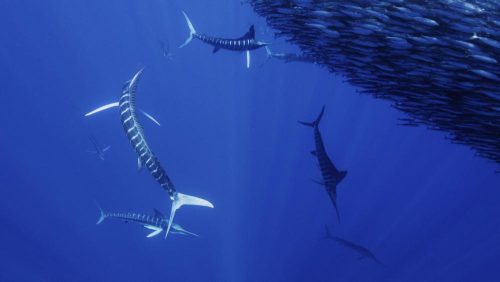
Striped marlin hunting a fish shoal (Photo Credit : Nick Price)
Some marine animals have developed hunting behaviors to obtain prey. Predatory fish such as sharks and killer whales use their sharp vision to locate and attack prey. Meanwhile, small fish tend to hunt in groups to increase effectiveness in finding and capturing food.
- Reproductive Behavior and Child Care
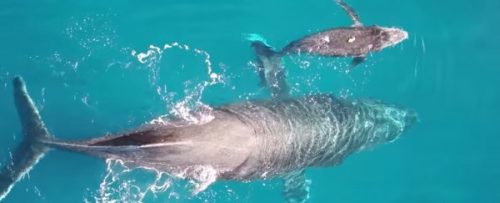
Humpback whales nursing their calves (Photo Credit : Science Alert)
Marine animals also have various behaviors to maintain the continuity of their species. Many species of fish and mollusks release millions of eggs at one time to increase survival chances. Whereas marine mammals like whales and dolphins nurture their offspring by breastfeeding and providing protection until the offspring become independent.
- Communication and Social Behavior
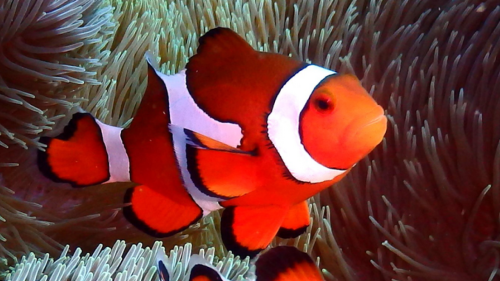
Clownfish change color to mark their territory (Photo Credit : OIST)
Marine animals also develop various communication behaviors, both verbal and non-verbal, to interact with each other. For example, dolphins use clicks and whistles to communicate, or clownfish change color to mark their territory.
- Migration and Movement to Find Food and Avoid Predators
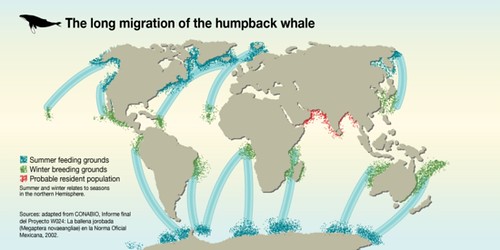
Long migration of humpback whale (Photo Credit : GRID-Arendal)
Many marine animals undergo seasonal migration or move from place to place to follow abundant food sources or avoid predators. For example, whales undertake annual migration between spawning areas and feeding areas. This strategy helps them meet their nutritional and safety needs.
- Formation of Groups and Collective Movement for Protection
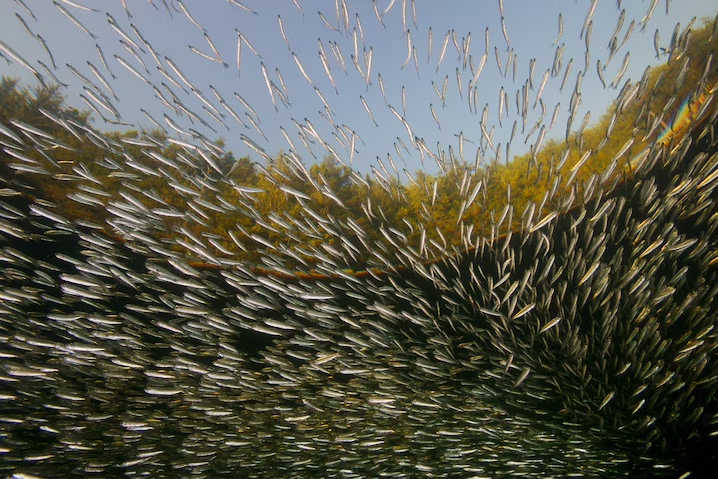
Pacific herring in British Columbia, Canada, come near shore in massive schools every spring to spawn (Photo Credit : Paul Nicklen)
Some marine animals live in groups or move together in schools. This behaviour provides protection from predators through an early warning system, distraction, and collective ability to ward off threats. For example, herring swim in large schools.
- Ability to Hide and Camouflage
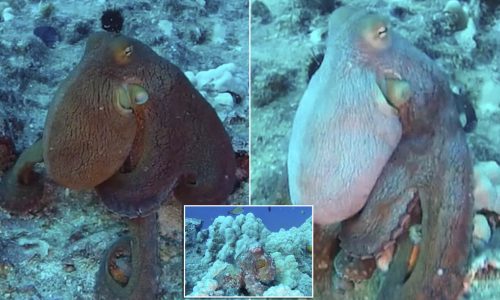
Octopus change colour to protect itself from predators (Photo Credit : Joe Pinkstone)
Marine animals also develop the ability to hide and camouflage as a form of adaptation against predators. For example, octopuses can change the colour and texture of their bodies to match their surroundings. This strategy helps them escape the attention of predators and increase survival chances.
- Migration and Movement of Marine Animals
- Reproductive Adaptations of Marine Animals
- Sex Change to Adapt to the Environment
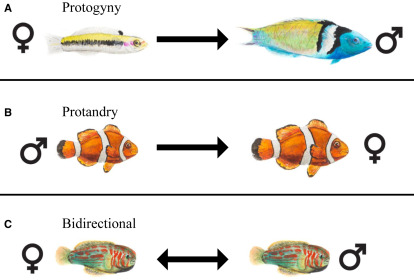
Sex changes in fish (Photo Credit : Haylee M. Quertermous & Neil J. Gemmell)
Some marine animals, such as clownfish and coral fish, have the ability to change their sex as a form of adaptation to the environment. This allows them to adjust the number of males and females in the population to optimize mating and reproduction opportunities.
- Ability to Produce Eggs or Give Birth to Offspring that Can Survive

Clownfish laying eggs (Photo Credit : Fantaseaaquariums)
As another strategy, many marine animals develop the ability to produce eggs or give birth to offspring that have high resistance to environmental conditions. For example, fish that release millions of eggs at once or marine mammals that give birth to relatively large offspring. This increases the chances of survival of their offspring.
- Sex Change to Adapt to the Environment
Conclusion
Marine animals have developed a variety of amazing adaptations to survive in the unique marine environment. These adaptations include sex changes, appropriate embryo and larval development, effective reproductive abilities, migration and movement, group formation, and the ability to hide and camouflage themselves. Through these adaptations, marine animals can meet their basic needs, such as finding food, avoiding predators, and reproducing. This allows them to survive in a challenging and competitive marine environment.
The marine environment is a habitat for a variety of animal species that have adapted extraordinarily. However, the marine environment is currently facing various threats, such as pollution, overfishing, and climate change. Therefore, it is crucial for us to preserve and protect the marine environment so that the diversity and survival of marine animals can be maintained. Conservation efforts, sustainable resource management, and reducing human impact on marine ecosystems are key steps that must be taken.

